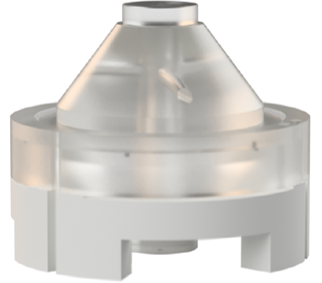Summary
Highly coherent lasers play an essential role in optical timekeeping.
Description

Cryogenic sapphire optical cavity for laser stabilization with reduced thermo-mechanical noise.
First, coherent laser interrogation of the narrowband electronic ‘clock’ transition is required to realize the very high spectroscopic resolution that make optical clocks so precise. At the same time, phase fluctuations in the laser interrogation can compromise the frequency stability of the optical clock through aliasing effects. In order to achieve the highest levels of optical coherence, lasers are typically frequency-stabilized to passive optical resonators, i.e. high-finesse optical cavities. By locking the laser frequency to an optical resonance of a cavity with extreme length stability, lasers with very high frequency stability and ultranarrow linewidths can be realized. The fundamental noise that limits this stabilization process is Brownian thermo-mechanical fluctuation of the cavity mirrors. We explore methods to minimize thermal noise processes to realize next-generation laser stabilization, as well as the application of these ultra-stable lasers to coherent spectroscopy of atoms. We work with optical cavities covering a range of materials, geometries, and reflector types, designed for either laboratory-based or transportable systems. Our current focus on extending laser frequency stability to the 10-17 fractional level utilizes a cryogenically-cooled (5K) sapphire optical cavity. We also explore spectroscopic techniques that utilize multiple cold atom samples to maximize coherent laser-atom interactions or clock frequency stability.
Relevant Publications
M. E. Kim et al., “Improved interspecies optical clock comparisons through differential spectroscopy,” Nature Physics 19 25 (2023).
T. Nakamura et al., “Coherent optical clock down-conversion for microwave frequencies with 10-18 instability,” Science 368 889 (2020).
M. Schioppo et al., “Ultrastable optical clock with two cold-atom ensembles,” Nature Photonics 11 48 (2017).
Y. Y. Jiang et al., “Making optical atomic clocks more stable with 10-16 level laser stabilization,” Nature Photonics 5 158-161 (2011).
W. McGrew et al., “Atomic clock performance enabling geodesy below the centimeter level,” Nature 564 87 (2018).
A. D. Ludlow et al., “Optical Atomic Clocks,” Rev. Mod. Phys 87 637-701 (2015).
N. Hinkley et al., “An atomic clock with 10-18 instability,” Science 341 1215-1218 (2013).
J. Davila-Rodriguez et al., “Compact, thermal-noise-limited reference cavity for ultra-low-noise microwave generation,” Optics Letters 42 1277-1280 (2017).
T. M. Fortier et al., “Generation of ultrastable microwaves via optical frequency division,” Nature Photonics 5 425-429 (2011).

